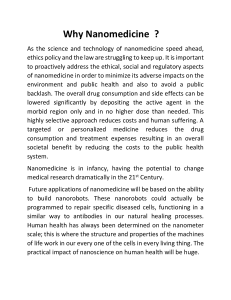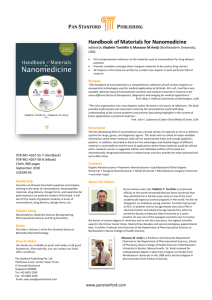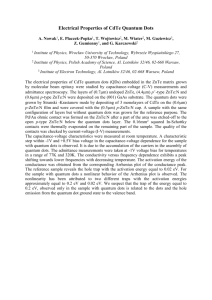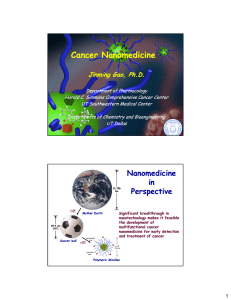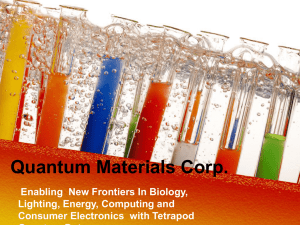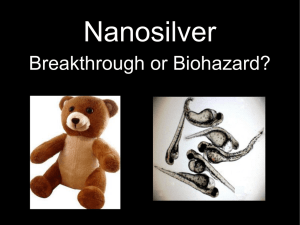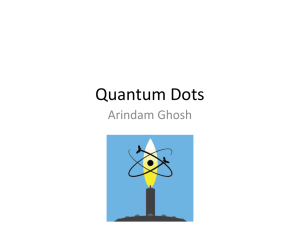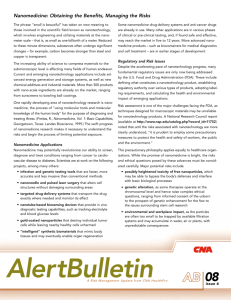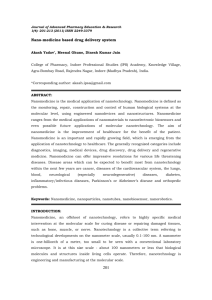Nano-Medicine - Chemistry Department
advertisement
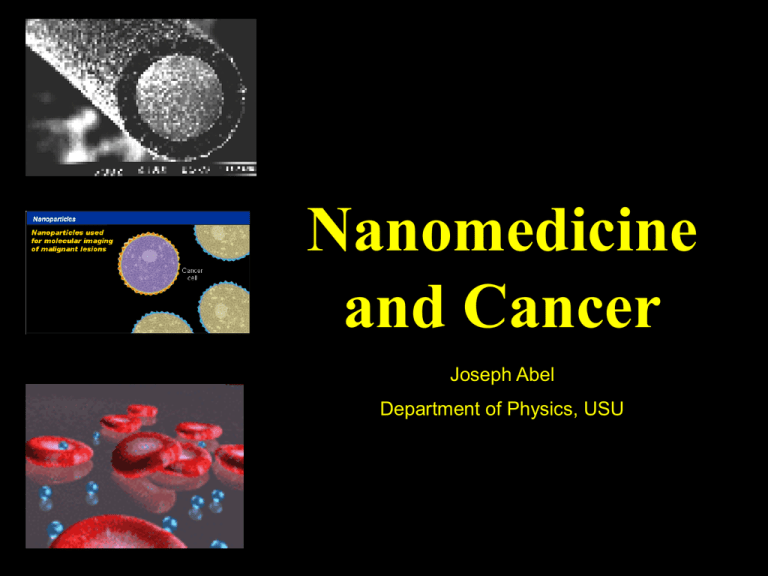
Nanomedicine and Cancer Joseph Abel Department of Physics, USU Why Nanomedicine? Virus Seeking Probes • Nanotechnology offers great advancements to medicine • There is still a lot to be learned about the human body and nanotechnology offers a lot of help. Artery Cleaner Source: http://science.nasa.gov/headlines/y2002/15jan_nano.htm Nano-Robots Replacing Neurons Source: http://www.e-spaces.com/Portfolio/trans/blood/index.html Source: http://foresight.org/Nanomedicine/Gallery/index.html Nano-Technology applied to Cancer Advantages of Nanoscale devices in Medicine • Devices smaller than 50 nm can easily enter most cells • Devices smaller than 20 nm can transit out of blood vessels • Devices are capable of holding thousands of small molecules • Contrast Agents • Drugs Major Areas of Development of Nanomedicine • Prevention and control • Early detection • Imaging diagnostics • Multifunctional Therapeutics Nanoparticles Reference: Ed Neuwelt, Oregon Health Sciences University Nanoparticle Contrast Agents Under Development Quantum Dots • unique optical and electronic properties such as: • size and composition • tunable fluorescence emission from visible to infrared wavelengths • large absorption coefficients across a wide spectral • range and very high levels of brightness and photo stability • colloidal quantum dots are the size of a typical protein Taken From: The use of nanocrystals in biological detecion, Paul Alivisatos In vivo Cancer Targeting and Imaging with Quantum Dots A summary of the report published by Xiaohu Gao, Richard M Levenson, Leland W K Chung & Shumming Nie Probe Design Tumor Targeting Behavior of Quantum Dots in Animals Histological Examination of QD Uptake Quantum Dots in Live Mouse Behavior of Quantum Dots in Animals Quantum Dots vs Organic Dyes Nanoparticle Contrast Agents Under Development Photonic Crystals Taken From: The use of nanocrystals in biological detecion, Paul Alivisatos Nanoshells Reference: Jennifer West, Rice University Properties of Gold Nanoshells • “Tunability” of the optical resonance Nanoshell-Enabled Photonics-Based Imaging and Therapy of Cancer, Christopher Loo, B.S.1, Alex Lin, B.S.1, Leon Hirsch, B.S.1,Min-Ho Lee, M.S.1,Jennifer Barton, Ph.D.2,Naomi Halas, Ph.D.3,JenniferWest, Ph.D.1,Rebekah Drezek, Ph.D.1 Images of Nanoshells Larger diameter nanoshells used for Imaging 120 nm radius and 35 nm shell thickness 100 nm radius and 20 nm shell thickness Smaller diameter nanoshells used for photothermal therapy applications 60 nm radius and 10 nm shell Nanoshell-Enabled Photonics-Based Imaging and Therapy of Cancer, Christopher Loo, B.S.1, Alex Lin, B.S.1, Leon Hirsch, B.S.1,Min-Ho Lee, M.S.1,Jennifer Barton, Ph.D.2,Naomi Halas, Ph.D.3,JenniferWest, Ph.D.1,Rebekah Drezek, Ph.D.1 Nanowire Sensor Reference: Jim Heath, California Institute of Technology Nano-Wires in Biosensing Silicon Nanowire Conductance Graphs Carbon Nanotube Taken From: The use of nanocrystals in biological detecion, Paul Alivisatos Nanoscale Cantilevers Cantilevers can be used as detectors of molecules. In this example specific molecules are attached to the cantilevers. The molecules selected are molecules that will bind to a specific molecule. When that molecule binds to the cantilever it changes the physical properties of the cantilever and that change can be detected. Reference: Arun Majumdar, University of California at Berkeley A team at the California Institute of Technology is using tiny cantilevers to probe molecular bonds. Nanomedicine - Conclusion • Nanotechnology will radically change the way we diagnose, treat and prevent cancer • Nanomedicine for cancer has the ability to improve health care dramatically • Current research is mostly in diagnostic tools, although there are many other application of nanomaterials in medicine… • There are still lots of advances needed to improve Nanomedicine
